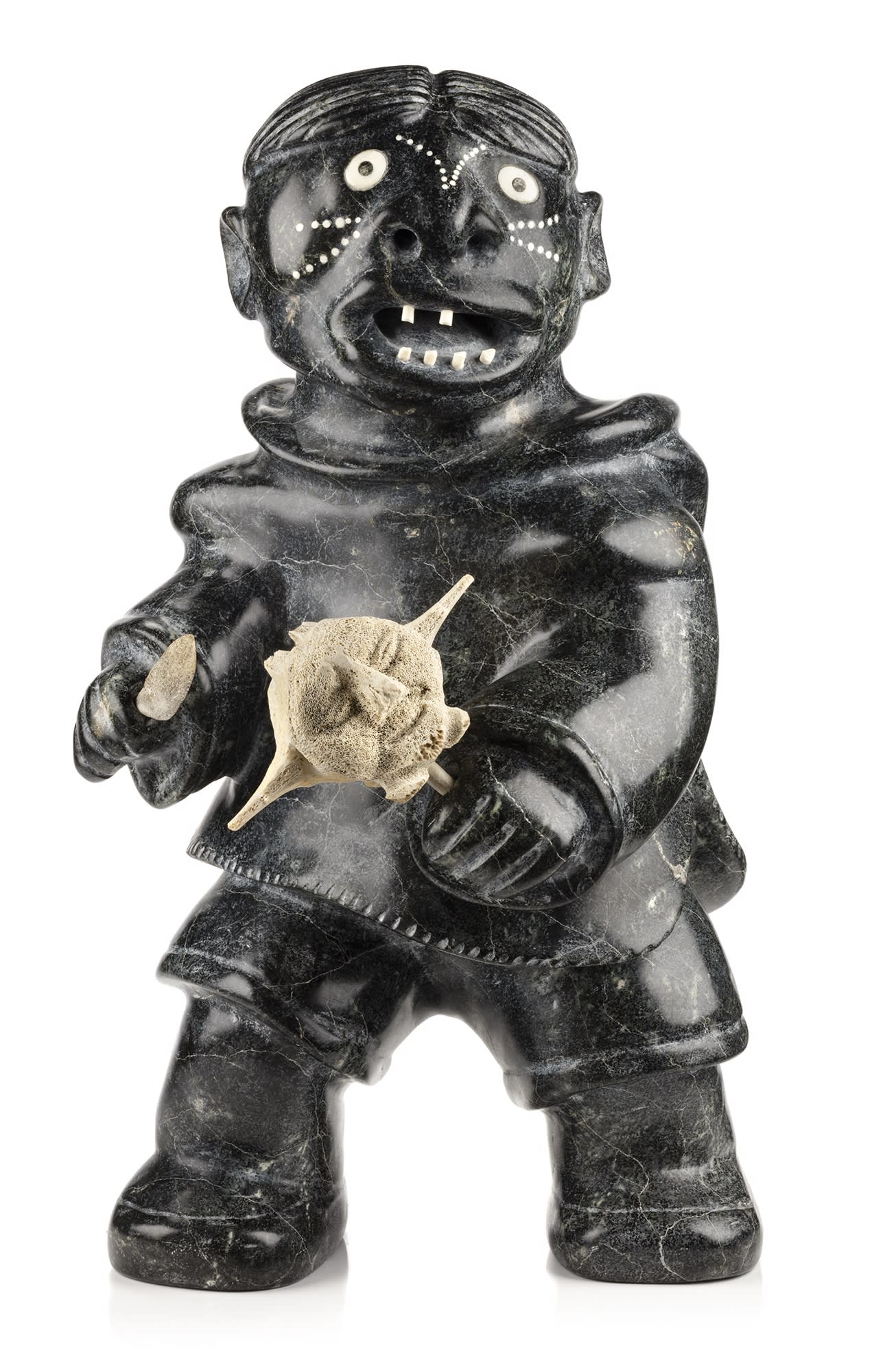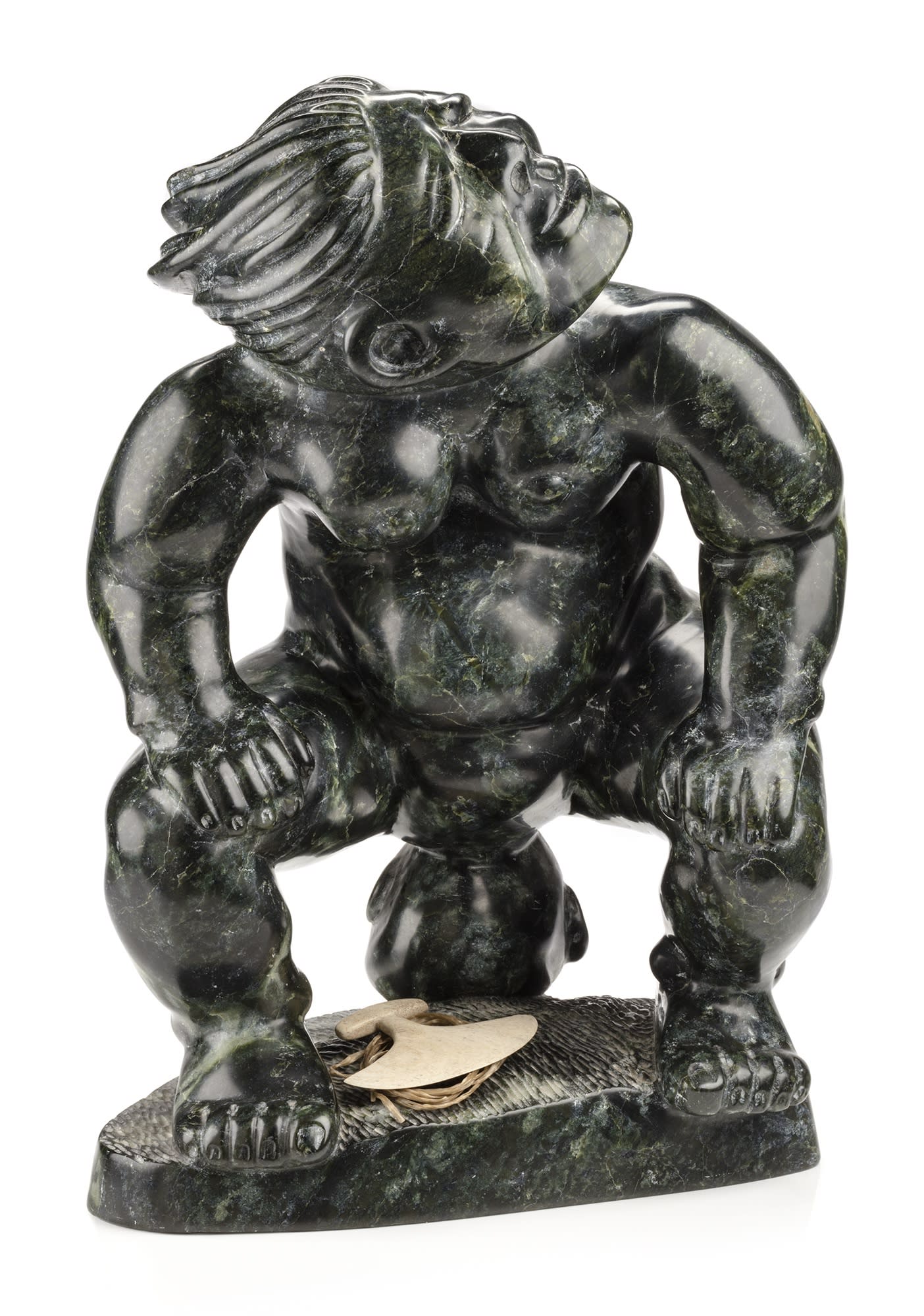The Netsilingmiut (People of the Seal) of the eastern Kitikmeot region were the last Inuit group to be influenced by Christianity and settled village life. They had not been affected by whaling, or much affected by fur trading, in the late nineteenth and early twentieth centuries. It’s not surprising, therefore, that the currents of shamanism and the supernatural ran deep in the art of this region right through to the end of the 20th century. Apart from the miniature ivories that had been carved in Kugaaruk (Pelly Bay) since the 1930s, there had been very little art making in the region until the late 1960s. With little suitable carving stone in the vicinity, whale bone was shipped by air into the village of Spence Bay (now Taloyoak) in 1968, and proved to be a powerful inspiration. Several local Inuit tried their hand at carving and produced many promising works. Among them was the young Karoo Ashevak, who was soon singled out as a special talent.



Lot 79
KAROO ASHEVAK (1940-1974) TALOYOAK (SPENCE BAY)
Spirit Figure with Eggs, c. 1972
whale bone, ivory, and stone, 23.5 x 6 x 3.5 in (59.7 x 15.2 x 8.9 cm)
ESTIMATE: $30,000 — $50,000
It is no exaggeration to say that Karoo Ashevak revolutionized Inuit sculpture in the early 1970s. This artist’s love of materials, tools, and tinkering, his willingness to explore the world of dreams, spirituality and shamanism, and the uninhibited exuberance with which he approached every aspect of his life combined to produce a stream of remarkable “surreal” constructions the likes of which had never been seen before. His work energized Inuit art collectors and attracted crossover collectors as well. And for good reason, it continues to do so today. With his solo exhibitions – particularly one in New York City – his sudden tragic death in a house fire in 1974, and his solo retrospective show at the Winnipeg Art Gallery in 1977, Karoo’s talent overshadowed the work of other artists.
Karoo’s influence on the art of the region was enormous, but eventually the work and styles of other artists became recognized and appreciated. This was especially true for three of Karoo’s uncles: the brothers Judas Ullulaq, Charlie Ugyuk, and Nelson Takkiruq. By 1985 Ullulaq had become the most famous of the three in the Southern art market, and is widely considered to have taken over Karoo’s mantle to become the most influential artist in the region. Together, these four artists left an indelible mark on the history of Inuit art. Each added his own stylistic flavour and favourite subject matter to the regional style now known as the “Kitikmeot School” of sculpture. Between them, they explored almost every aspect of the supernatural, the psychological, and the expressionistic in their work. Remarkable.
We at First Arts are honoured to offer powerful works by each of these four artists this season. Karoo’s Spirit Figure with Eggs was purchased from the Lippel Gallery in Montreal in 1973 and has remained in the same family since then. We are proud to now offer this fine work to the market for the first time in over fifty years.
All hailing from the same prominent Toronto collection, the three important sculptures by Ullulaq, Takkiruq, and Ugyuk were all featured in Darlene Coward Wight’s seminal exhibition Art & Expression of the Netsilik at the Winnipeg Art Gallery in 1997-1998, and all are illustrated in the catalogue published in 2000.


Lot 49
JUDAS ULLULAQ (1937-1999), UQSUQTUUQ (GJOA HAVEN)
The Shaman Who Could Fly, c. 1990
whale bone, sinew, and stone, 17 x 20 x 8 in (43.2 x 50.8 x 20.3 cm)
ESTIMATE: $12,000 — $18,000
Judas Ullulaq became recognized as an important talent by the late 1970s when he was still living in Taloyoak. However, his career really took off in the early 1980s, which coincided with his move to neighbouring Gjoa Haven. This reunited him with his brother Nelson Takkiruq, and the two became very close. Several solo exhibitions in the South cemented Ullulaq’s reputation as the most important and influential artist of the region.
Flight is this shaman’s only form of transportation. As he had no dogs, this is how he went hunting. The head in the shaman’s hand is his helping spirit. (Ullulaq, 1997, in Darlene Coward Wight, Art & Expression of the Netsilik, p. 168.)
On the same page in her Netsilik catalogue, Darlene Wight describes Ullulaq’s detailed personal account of an experience with shamans. It finishes with the sentence: “From that day on, he knew that angakuq [shaman] stories are very true and that they are very powerful.” These words should leave no one in doubt as to the ongoing strength of belief in shamanism and spirits among many older Netsilingmiut, and Judas Ullulaq in particular. This belief not only inspires the imagery of Ullulaq’s art, it also quite literally infuses his sculptures with their magic and potency. Their humour and charm derive from the man himself.
Judging from Ullulaq’s description and what we see in this remarkable sculpture, we think it is safe to assume that the shaman’s power derives from the helping spirit in the form of a smiling head. The shaman and the bird are one and the same. Of necessity, he transforms into a bird to be able to hunt. Ullulaq’s people often wear angst-filled facial expressions, but this shaman is clearly delighted with his good fortune and his abilities. His arms raised in joy mirror the raised wings of the bird at the rear. The bird image is etched onto the denser outer surface of this ancient piece of weathered whale bone.

Lot 34
NELSON TAKKIRUQ (1930-1999), UQSUQTUUQ (GJOA HAVEN)
Tattooed Woman Holding Mask, 1988
stone and bone, 21.25 x 11.5 x 12.25 in (54 x 29.2 x 31.1 cm)
ESTIMATE: $7,000 — $10,000
Nelson Takkiruq was adopted out at birth and did not meet his brothers, Judas Ullulaq and Charlie Ugyuk, until he was an adult. Nelson and Judas became close and shared a lively sense of humour and positive attitude; they even looked strikingly similar. Takkiruq apparently began carving in the early 1950s, selling small works in bone and antler to local missionaries. He sold work to the local co-op regularly in the 1970s and, influenced by the style and success of Judas (who joined him in Gjoa Haven in 1982), he also became a major sculpting talent, carving right until his death in 1999.
This impressive tattooed figure probably depicts a dancing and chanting female shaman summoning a helping spirit. The mask-like spirit face is carved from a vertebra whose naturally occurring winged shape suggests that it’s a bird spirit. Like Ullulaq, Takkiruq carved both stone and bone, and enjoyed mixing materials for heightened psychological and aesthetic effect.


Lot 35
CHARLIE UGYUK (1931-1998), TALOYOAK (SPENCE BAY)
Woman Giving Birth, c. 1988
stone, antler, and waxed string, 18.5 x 12.25 x 8.5 in (47 x 31.1 x 21.6 cm)
ESTIMATE: $4,000 — $6,000
Brother of the carvers Judas Ullulaq and Nelson Takkiruq, Charlie Ugyuk lived on the land on the Boothia Peninsula and King William Island until his move to Taloyoak in 1970. He had begun carving already in the mid 1960s and is considered to have been an influence on his brothers, Karoo Ashevak, and others. (Arguably, Ugyuk was little influenced by Karoo’s own style or success, and stubbornly followed his own artistic path.) Ugyuk often worked in a highly realistic style - he is admired for his depictions of falcons and polar bears, for example - but he is most famous for his sculptures featuring shamanic and demonic subject matter in the latter half of his career, many of which were decidedly grotesque. Much of his imagery illustrated the conflict between Christianity and shamanism, and was no doubt influenced by his personal demons of alcohol and violence.
This is a remarkable sculpture that possesses some of the raw energy of Ugyuk’s demonic works but has none of their grotesque aspects. It is, in fact, a powerful image of female strength and resilience. This Woman Giving Birth is on her own, without a midwife or helpers, and so must cope as best she can. So far so good: the mother has assumed a squatting stance and looks skyward perhaps for added strength and divine encouragement; her infant is alive and wailing, so that is a promising sign.
